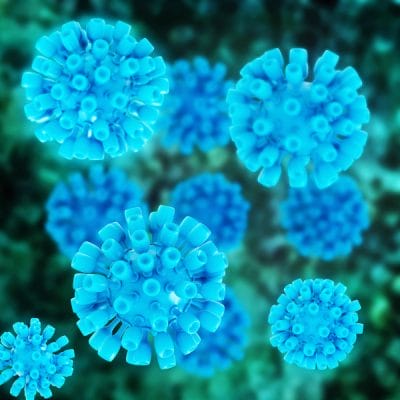This summer a case of paralytic polio was reported to the CDC. I’ve been getting a number of questions from my community, so I’ve written a three-part series of articles explaining what parents need to know about polio. This article is about the inactivated polio vaccine.
- What Is Polio? How is it Prevented & Treated?
- How Do Polio Vaccines Cause Polio?
- Inactivated Polio Vaccine: What Parents Need To Know
Some parents may be reevaluating their choices regarding the polio vaccine. This article aims to provide all the information that parents need to make an informed choice about the inactivated polio vaccine.
What Is Polio?
Poliomyelitis (aka polio) is a highly infectious disease caused by an intestinal virus called poliovirus. The vast majority of polio cases are asymptomatic (~75%). Some people with polio (20-25%) may get flu-like symptoms. Severe polio cases occur in less than 1% of people and can result in encephalitis, lifelong paralysis, and even death.
Post Polio Syndrome occurs in 30-40% of polio patients. It involves muscle pain, weakness, and fatigue, among other symptoms.
Read more: What is Polio? How is it Prevented & Treated? – Dr. Green Mom
How Common Are Serious Polio Outcomes?
Approximately 1/200 people diagnosed with polio go on to develop paralytic polio. 5-15% of people with paralytic polio will develop paralysis of the lungs and die. Two-thirds of paralytic polio cases result in lifelong paralysis.
Polioencephalitis is a rare form of polio that causes swelling of the brain and occurs mainly in infants. I have not been able to find enough reliable information to determine its frequency.
How Effective Is The Inactivated Polio Vaccine?
According to the CDC, two doses of the inactivated polio vaccine confer 90% immunity and three doses confer 99% immunity. The duration of immunity is uncertain, but it is assumed to be lifelong.
Polio Vaccine Schedules
The standard American polio vaccine schedule is a series of three doses given at 2 months, 4 months, and 6 months of age with a final booster at 4-6 years.
If an individualized vaccine schedule is being followed, the first three doses of polio vaccine are given 8 weeks apart with the booster dose being given 6-12 months later. In my medical practice, I usually recommend two doses of the polio vaccine before age 4 (which gives 90% protection) and then a third and final dose after age 4, and at least six months after the second dose (to provide 99% protection).
If an accelerated vaccine schedule is required (eg. during an outbreak), the doses in the initial series may be given 4 weeks apart. The minimum time interval between the original series and the booster is 6 months. Shorter time intervals between polio vaccine doses may result in decreased vaccine efficacy so this schedule is only to be used if there is an imminent risk of exposure.
Should Adults Get Polio Vaccines?
Most adults who have been vaccinated against polio do not need a booster shot. However, people at higher risk for contracting polio (laboratory workers, healthcare workers, travelers to polio-endemic areas) may need a booster depending on their vaccination history.
Unvaccinated adults are given two initial doses 8 weeks apart and a third dose 6-12 months later.
How Common Are Side Effects From The Inactivated Polio Vaccine?
The inactivated polio vaccine causes very few systemic side effects and is one of our safest vaccines. The most common systemic side effects of the polio vaccine are drowsiness, irritability, joint pain, body aches, vomiting, and fever.
Local reactions (redness, swelling, tenderness) occur in approximately 10% of people who get the polio vaccine.
For more information about the frequency of side effects, see the package inserts of the various polio containing vaccines:
Package Insert – IPOL (Inactivated polio vaccine)
Package Insert – Pentacel – (inactivated poliovirus component grown in MRC-5 cells) (Inactivated polio, diphtheria, tetanus, acellular pertussis, and hemophilus B combination vaccine)
Package Insert – PEDIARIX (Inactivated polio, diphtheria, tetanus, acellular pertussis, and hepatitis B combination vaccine)
Package Insert – Kinrix (Inactivated polio, diphtheria, tetanus, and acellular pertussis combination vaccine)
Who Shouldn’t Get The Inactivated Polio Vaccine?
People who have had allergic reactions to any of the ingredients in the polio vaccine shouldn’t get it. Polio vaccines may contain trace amounts of neomycin, streptomycin, and polymyxin B, so people with allergies to any of these antibiotics may have to avoid the polio vaccine. The polio vaccine may also contain trace amounts of formaldehyde which some people are sensitive to. Consult with your healthcare provider as needed.
People with moderate or severe illnesses of any type should avoid the polio vaccine until they are well. Moderate or severe illness may make the vaccine less effective. It may also make it unclear if the vaccine is causing any side effects because the symptoms of the illness could overlap with vaccine side effect symptoms.
The polio vaccine hasn’t been tested in pregnant or breastfeeding women. Pregnant or breastfeeding women should avoid the vaccine unless the risk outweighs the benefit (eg. during an outbreak). Consult with your healthcare provider if you’re unsure.
There are some groups of people that require extra care around vaccinations in general. For example, people with a family history of autoimmune conditions would be wise to give extra support to the immune system. People with MTHFR and/or related genetic polymorphisms may want to provide extra support for the methylation pathways during vaccination.
Polio Vaccine Controversies
The polio vaccine has been at the center of some controversies. These include vaccine-derived paralytic polio, simian virus 40, and some controversial vaccine ingredients.
Vaccine Derived Paralytic Polio
Vaccine Derived Paralytic Polio is caused by live viruses found in the oral polio vaccine. The oral polio vaccine isn’t used in the United States, but cases may still be imported from other regions in the world. The 2022 case of paralytic polio in New York was a result of vaccine-derived poliovirus.
The inactivated vaccine given in the United States cannot cause vaccine-derived paralytic polio.
Simian Virus 40 (SV40)
Simian Virus 40 (SV40) is not a concern in 2022. However, for a period of eight years during the 1950s and 1960s, SV40 was found to have contaminated approximately 30% of all polio vaccines. Research is ongoing to try to determine the effects that SV40 has had on the population.
Controversial Ingredients In the Polio Vaccine
Aborted fetal cells (MRC-5 cells) are used to create the polio vaccine component of PENTACEL. The other vaccines use different, less controversial cell lines. See the package inserts above for more details.
Aluminum is present in some of the combination polio vaccines.
Formaldehyde is commonly used as a preservative in vaccine development and is present in tiny doses in many vaccines. Formaldehyde is important for preventing contamination with bacteria and viruses (like SV40) and is used to inactivate the polio virus for the injected vaccine.
See this page for more information about vaccine ingredients in general: Vaccine Ingredients
Summary
Based on my research and clinical experience, I believe the inactivated polio vaccine to be one of the safest and most effective vaccines available. It is important for both personal and public health.
If you are in an area where the polio virus is circulating, ensuring that your family is up to date with recommended vaccines is wise if your medical history allows it.
Ultimately, medical decisions like vaccination are personal and should be made in partnership with your healthcare provider. Medical history, family history, disease risk, and family values all play a role in medical decisions.
References:
Poliomyelitis – StatPearls – NCBI Bookshelf
Dang-Tan, T., Mahmud, S. M., Puntoni, R., & Franco, E. L. (2004). Polio vaccines, Simian Virus 40, and human cancer: the epidemiologic evidence for a causal association. Oncogene, 23(38), 6535–6540. https://doi.org/10.1038/sj.onc.1207877
Carroll-Pankhurst, C., Engels, E. A., Strickler, H. D., Goedert, J. J., Wagner, J., & Mortimer, E. A., Jr (2001). Thirty-five year mortality following receipt of SV40- contaminated polio vaccine during the neonatal period. British journal of cancer, 85(9), 1295–1297. https://doi.org/10.1054/bjoc.2001.2065
Ming, L. C., Hussain, Z., Yeoh, S. F., Koh, D., & Lee, K. S. (2020). Circulating vaccine-derived poliovirus: a menace to the end game of polio eradication. Globalization and health, 16(1), 63. https://doi.org/10.1186/s12992-020-00594-z
Carbone, M., Gazdar, A., & Butel, J. S. (2020). SV40 and human mesothelioma. Translational lung cancer research, 9(Suppl 1), S47–S59. https://doi.org/10.21037/tlcr.2020.02.03
Reif, D. M., McKinney, B. A., Motsinger, A. A., Chanock, S. J., Edwards, K. M., Rock, M. T., Moore, J. H., & Crowe, J. E. (2008). Genetic basis for adverse events after smallpox vaccination. The Journal of infectious diseases, 198(1), 16–22. https://doi.org/10.1086/588670
Heidary, N., & Cohen, D. E. (2005). Hypersensitivity reactions to vaccine components. Dermatitis : contact, atopic, occupational, drug, 16(3), 115–120.
Abd-Elghaffar, A. A., Rashed, M. E., Ali, A. E., & Amin, M. A. (2020). In-Vitro Inactivation of Sabin-Polioviruses for Development of Safe and Effective Polio Vaccine. Vaccines, 8(4), 601. https://doi.org/10.3390/vaccines8040601
Toussirot, É., & Bereau, M. (2015). Vaccination and Induction of Autoimmune Diseases. Inflammation & allergy drug targets, 14(2), 94–98. https://doi.org/10.2174/1871528114666160105113046


